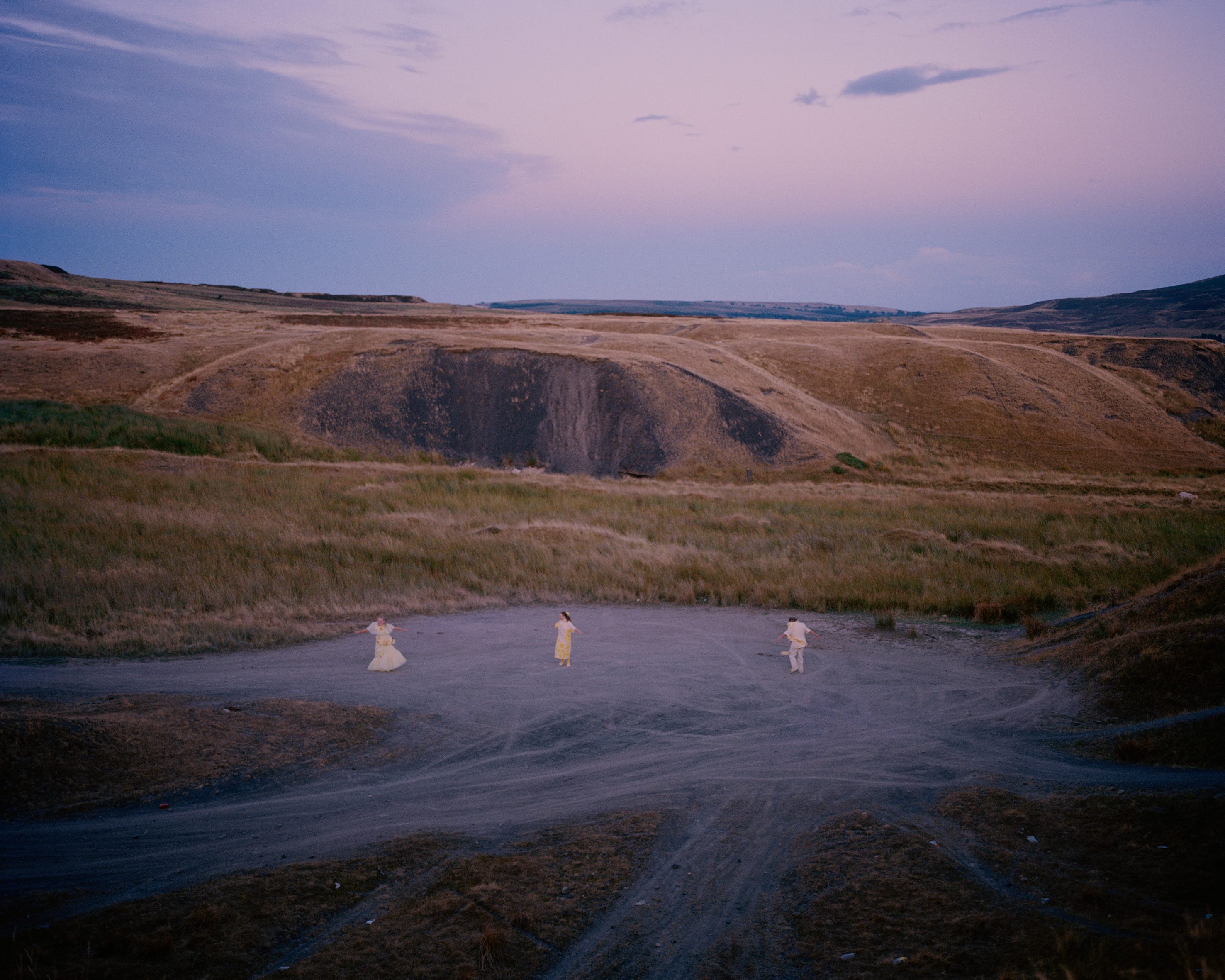Celebrating style in post-industrial South Wales
- Text by Eva Clifford
- Photography by Clementine Schneidermann and Charlotte James

When a group of kids catch sight of five young girls dressed in all-black with lace gowns and extravagant hats crossing an estate in South Wales, their initial reaction is bemusement.“What are you wearing?! You look like you’re dressed for a funeral!” Unfazed by their comments, one of the girls – Sassy Keely – replies: “It’s called fashion, look it up!”
Collaborating with local children, photographer Clementine Schneidermann and stylist Charlotte James’ ongoing project It’s Called Ffasiwn merges fashion, performance and documentary photography to present a contemporary vision of the post-industrialised landscape of the south Wales Valleys.
Since they both live in Wales, it seemed a natural place for the pair to make work. Visually, the region offers variety: “we can shoot on an estate, then drive 10 minutes and shoot a countryside landscape, or drive half an hour to a seaside town,” says Charlotte. “It’s also important for us to show creative practices happening outside of the big cities.”
While the disappearance of the coal mining industry in the 1980s has had a long-lasting impact on opportunities in the region, Schneidermann and James were keen to show the area in a different light. They wanted to move away from mainstream representations of working class community life that focuses predominantly on hardship and deprivation. “Without denying the reality, the playfulness of the photos break with the traditional distance that you often see between the people behind the cameras and their subjects,” says Clementine.

Demi, Bryn Farm 2018

Nia (Valentine Disco Party), Gurnos 2018
Before any shoot takes place, the pair decide on a theme and then organise fashion workshops with local youth centres. Most of the children involved belong to two separate youth clubs in two different towns, and responses to the project have so far been positive. “When they pose for the photos, they really take it seriously,” says Clementine. “They’re also able to forget the judgement from people on the street, and walk into their own estate with extremely unusual costumes without caring too much about what people will think. It’s like an experimental drama play and the street is turned into a stage.”
For the workshops, Charlotte sources clothing and materials, gathers visual inspiration for the children to look at, and then allocates them various tasks, so that they too are actively involved in the creative process.
“It could be ruffle making, painting onto the clothes, adding gems, or working on the set design,” explains Charlotte. “For the summer school, we gave the young people a budget so they could source clothing from charity shops as well. I’m there to help and advise them, but I like them to have as much input as they want.”
“This process has been a learning curve for us too, because running a workshop for lots of kids with time and money constraints (we self-funded the project for three years) hasn’t been easy, but I think the summer school cemented our practice on how we’ll continue to work with youth.”

Spring, Gurnos, 2017

Summer Street Party, Merthyr Vale, 2018
Although they tend to have a fixed idea on the costumes and location, shooting outside brings its own challenges. “It rains more than it shines in this part of the world,” Clementine says, so costumes can quickly get damaged which this means they often have to shoot in a rush. Also, the energy and dynamic of the group has an impact on the final photographs. “The photos never end up the way we expect them to be,” she admits.
One constant element in the photos is colour. As their first colour co-ordinated shoot involved the black costumes for Halloween, they’ve since “tried to base each colour and shoot on a season or celebration, such as red for Valentine’s day, pastel green for spring and yellow for summer, etc.” explains Charlotte.
The result is a striking deviance from the typical visual representations of the region. “The communities in the Valleys have been beautifully photographed during the mining days,” says Clementine. “Although in appearance the Valleys haven’t changed that much, we’re interested in moving away from these iconic photos of Industrial Wales and finding an original way of representing the contemporary Valleys.”

Valentine Disco Party, Gurnos Social Club 2018

Ghosts, Merthyr, 2018
Approaching the project from two distinct backgrounds (Clementine studied documentary photography and Charlotte studied fashion), the collaboration has been beneficial in many ways. “Charlotte and I are very complimentary,” says Clementine. “Because the work is multidisciplinary, having two brains allows us to go further in our ideas and take more risks.”
“Clementine takes the photographs but we have fluid roles within the collaboration,” adds Charlotte. “The project only exists due to the creative partnership we have built over the years.”
Recalling their first Halloween shoot on the estate, the two decided to name the project after Sassy Keely’s comeback, replacing ‘fashion’ with the Welsh translation “Ffasiwn”. Charlotte says: “It’s a play on the word and how even though we’re introducing the girls to fashion in a creative way, the project couldn’t be further away from your typical fashion shoot.”

Last Days of Summer, Blaenavon 2018

Autumn, Coed Cae, 2016
It’s Called Ffasiwn will be exhibited for the first time at the Martin Parr Foundation in March.
Enjoyed this article? Like Huck on Facebook or follow us on Twitter.
Latest on Huck

Bernie Sanders introduces Clairo at Coachella, urging young Americans to “stand up for justice”
Coachella charmed — The Vermont Senator praised the singer-songwriter for her efforts in raising awareness of women’s rights issues and Gaza.
Written by: Isaac Muk

The Changing Face Of Brooklyn, New York’s Most Colourful Borough
After three decades spent capturing stories around the world, Magnum Photographer Alex Webb finally decided to return home to Brooklyn – a place that champions chaos, diversity and community spirit.
Written by: Alex Webb / Magnum Photos

The mundane bliss of New York’s subways in the ’70s
NYC Passengers 1976-1981 — During a very different decade in NYC, which bounced between rich creativity and sketchiness, photographer Joni Sternbach captured the idiosyncratic isolation found on its rail networks.
Written by: Miss Rosen

Analogue Appreciation: lullahush
Ithaca — In an ever more digital, online world, we ask our favourite artists about their most cherished pieces of physical culture. Today, it’s Irish retro-futurist lullahush.
Written by: lullahush

Spyros Rennt captures connection and tenderness among Berlin’s queer youth
Intertwined — In the Greek photographer’s fourth photobook, he lays out spreads of togetherness among his friends and the German capital’s LGBTQ+ party scene.
Written by: Isaac Muk

The rebellious roots of Cornwall’s surfing scene
100 years of waveriding — Despite past attempts to ban the sport from beaches, surfers have remained as integral, conservationist presences in England’s southwestern tip. A new exhibition in Falmouth traces its long history in the area.
Written by: Ella Glossop